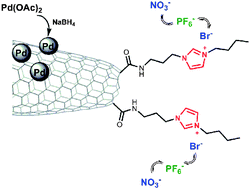Imidazolium modified carbon nanohorns: switchable solubility and stabilization of metal nanoparticles†‡
Abstract

* Corresponding authors
a
Theoretical and Physical Chemistry Institute, National Hellenic Research Foundation, 48 Vassileos Constantinou Avenue, Athens, Hellas
E-mail:
tagmatar@eie.gr, nkarou@eie.gr
Fax: + 30 210 7273794
Tel: + 30 210 7273835
b Nanotube Research Center, National Institute of Advanced Industrial Science and Technology (AIST), Central 5, Higashi, Japan
c Department of Chemistry, Nagoya University, Nagoya, Japan

 Please wait while we load your content...
Something went wrong. Try again?
Please wait while we load your content...
Something went wrong. Try again?
N. Karousis, T. Ichihashi, S. Chen, H. Shinohara, M. Yudasaka, S. Iijima and N. Tagmatarchis, J. Mater. Chem., 2010, 20, 2959 DOI: 10.1039/B925169C
To request permission to reproduce material from this article, please go to the Copyright Clearance Center request page.
If you are an author contributing to an RSC publication, you do not need to request permission provided correct acknowledgement is given.
If you are the author of this article, you do not need to request permission to reproduce figures and diagrams provided correct acknowledgement is given. If you want to reproduce the whole article in a third-party publication (excluding your thesis/dissertation for which permission is not required) please go to the Copyright Clearance Center request page.
Read more about how to correctly acknowledge RSC content.
 Fetching data from CrossRef.
Fetching data from CrossRef.
This may take some time to load.
Loading related content
